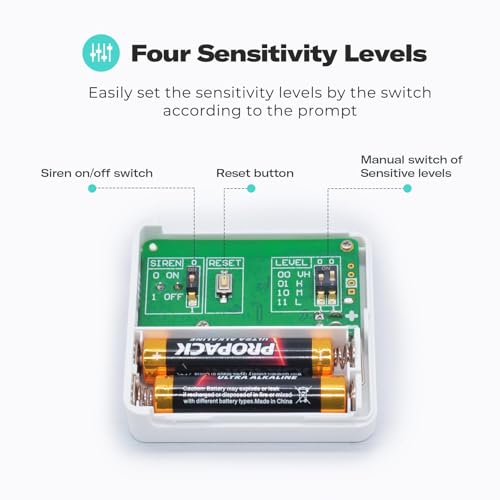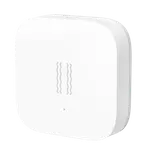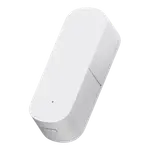Summary
Size & Materials: 67.75g / 2.39oz, 55.88 x 55.88 x 12.19 mm
Connectivity: Zigbee (Zigbee hub required)
Integrations: Alexa, Samsung SmartThings, Home Assistant
Sensors: Vibration, Drop
Alerts: Vibration Alerts, Drop Alerts
Features: On Device Alert Sound, Sensitivity
Price History
Loading price history...
| Brand | Third Reality |
|---|---|
| Headquarters | |
| Website | https://3reality.com |
| @ThirdRealityInc |
Size & Materials
Length x Width x Height
- Length: the longest side of the device
- Width: the shorter side of the device
- Height: the vertical dimension of the device
55.88 x 55.88 x 12.19 mm
The physical weight of the device, typically measured in grams (g) or ounces (oz).
Weight can be important for installation considerations, especially for wall-mounted or battery-powered devices.
67.75g / 2.39oz
Power
Battery-powered sensors typically use standard batteries like AA, AAA, or button-cell batteries (CR2032, CR123A), which are easy to replace and widely available.
2x AAA
Sensors that connect via Wi-Fi tend to consume more power due to the constant need to maintain a connection with the network, meaning more frequent battery replacements.
Zigbee, Z-Wave, and Thread Sensors are designed for low-power devices, allowing sensors to last much longer on battery power, often up to 3-5 years before needing a battery change.
Bluetooth Low Energy (BLE) sensors have moderate power consumption, offering a reasonable battery life depending on usage.
1 year
Connectivity
Range: The 2.4 GHz band offers a longer range, meaning it can cover larger areas and penetrate solid objects like walls more effectively than 5 GHz.
Speed: Generally, 2.4 GHz provides slower speeds compared to 5 GHz due to a lower maximum data rate.
Interference: More prone to interference since many other devices (like cordless phones, microwaves, and Bluetooth devices) operate on the 2.4 GHz frequency, leading to potential congestion and slower network performance.
NO
Range: Offers a shorter range compared to 2.4 GHz and may have difficulty penetrating walls and other obstacles.
Speed: Typically provides faster speeds and higher data rates due to more available bandwidth.
Interference: Less prone to interference as fewer devices operate on this frequency, leading to a more stable connection.
NO
Bluetooth is a wireless communication technology used for exchanging data over short distances.
Bluetooth enables devices to communicate wirelessly within a short range, typically up to 10 meters (about 33 feet) for most consumer devices.
NO
Zigbee is a wireless communication protocol designed for low-power, short-range applications, commonly used in smart home devices, industrial automation, and other areas requiring reliable, low-data rate communication. It features low power consumption, making it ideal for battery-operated devices, and supports short-range communication, typically up to 100 meters. Zigbee employs mesh networking, allowing devices to relay data through each other to extend range and improve reliability. It supports data rates up to 250 kbps, suitable for small data packets, and ensures interoperability among devices from different manufacturers if they conform to Zigbee standards. Security is robust, with AES-128 encryption for data protection.
Z-Wave is known for its low power consumption, making it ideal for battery-powered devices. It supports a mesh networking topology, allowing devices to communicate with each other directly or through intermediary nodes, thus extending the overall network range and enhancing reliability. The protocol supports data rates of up to 100 kbps, suitable for transmitting control commands and sensor data.
NO
Zigbee is a wireless communication protocol designed for low-power, short-range applications, commonly used in smart home devices, industrial automation, and other areas requiring reliable, low-data rate communication. It features low power consumption, making it ideal for battery-operated devices, and supports short-range communication, typically up to 100 meters. Zigbee employs mesh networking, allowing devices to relay data through each other to extend range and improve reliability. It supports data rates up to 250 kbps, suitable for small data packets, and ensures interoperability among devices from different manufacturers if they conform to Zigbee standards. Security is robust, with AES-128 encryption for data protection.
Zigbee devices need a Zigbee-compatible hub to connect and communicate with other devices in your smart home setup.
Zigbee hub required
Utilizing the Zigbee 3.0 standard, it is capable of integrating smoothly with a range of Zigbee hubs and devices, including popular Zigbee Echo devices, such as Echo (4th Gen), Echo Plus (1st Gen and 2nd Gen), Echo Show 10 (2nd Gen and 3rd Gen), Echo Studio, Eero 6, Eero Pro 6, SmartThings, Home Assistant (ZHA and Z2M), Hubitat, and Third Reality smart hub Gen2.
Thread is a wireless communication protocol designed specifically for Internet of Things (IoT) devices, providing secure, reliable, and scalable networking. Unlike some other protocols, Thread is IP-based, which means it can seamlessly integrate with existing internet infrastructure. It operates in the 2.4 GHz frequency band and uses mesh networking to enhance reliability and extend range by allowing devices to relay data through each other.
Thread is optimized for low power consumption, making it suitable for battery-operated devices. It supports low-latency communication, which is crucial for real-time applications like home automation and security systems. The protocol ensures high security with AES-128 encryption and end-to-end security at the network layer. Thread also supports over-the-air updates, ensuring devices can stay up to date with the latest features and security patches.
Thread-enabled devices require a Thread Border Router (such as certain smart home hubs or routers) to connect to your home network and other Thread devices.
NO
Integrations
Google Home serves as a central hub for a variety of smart devices, including lights, thermostats, cameras, and speakers. It leverages Google Assistant for voice control, enabling users to manage their smart home with simple commands.
NO
Amazon Alexa is one of the most widely used smart home systems, known for its compatibility with a vast array of devices. Users can control everything from smart lights to appliances using voice commands through Echo devices.
YES
Apple HomeKit is designed for users in the Apple ecosystem, providing a seamless way to control compatible smart devices through iOS devices using the Home app or Siri. It emphasizes security and user privacy.
NO
SmartThings is a flexible platform that connects a wide range of devices from different brands, offering a unified interface for control. It supports various communication protocols, allowing for extensive device compatibility.
YES
Home Assistant is an open-source platform that allows for extensive customization and integration of a wide variety of smart devices. It supports a multitude of protocols and brands, making it ideal for tech-savvy users.
YES
IFTTT (If This Then That) is a web-based service that allows users to create simple automation sequences, known as applets, which enable different devices, services, and applications to work together seamlessly. It connects a wide range of products and services, facilitating interoperability and enhancing functionality.
NO
Matter is a unified, open-source connectivity protocol designed to standardize and simplify communication between smart home devices from different manufacturers. Developed by the Connectivity Standards Alliance (formerly the Zigbee Alliance), Matter aims to improve interoperability, security, and reliability across various smart home ecosystems.
Matter operates over existing networking technologies, including Ethernet, Wi-Fi, and Thread, providing flexibility in device connectivity. Its IP-based nature allows seamless integration with existing internet infrastructure and cloud services. Matter uses a mesh networking topology, particularly when operating over Thread, to enhance range and reliability by allowing devices to relay data through each other.
Security is a cornerstone of Matter, with end-to-end encryption and secure device onboarding processes ensuring robust protection for data and privacy. Matter also supports over-the-air updates, allowing devices to stay current with the latest features and security enhancements.
NO
Sensors
Detection of physical vibrations, shocks, or movement of the device itself.
Vibration sensors can detect when the device is moved, shaken, or experiences physical disturbances for security and monitoring purposes.
YES
Detection of changes in orientation or angle of the device itself.
Tilt sensors can alert you when the device is tilted, rotated, or changes position.
?
Detection of sudden falling or dropping motion of the device itself.
Drop sensors can alert you when the device falls or is knocked over.
YES
Alerts
Notifications when vibration or movement is detected on the device itself.
Vibration alerts can indicate when the device is moved, shaken, or experiences physical disturbances for security and monitoring purposes.
YES
Notifications when the device's orientation changes are detected.
Tilt alerts can warn when the device itself has been moved or repositioned, indicating potential tampering or displacement.
?
Notifications when the device itself falls or is dropped.
Drop alerts can indicate when the sensor has been knocked over, fallen, or physically tampered with.
YES
Notifications when the device's battery level becomes critically low.
Battery alerts ensure you can replace or recharge batteries before the device stops functioning.
?
Features
Local audible alerts produced by the device itself.
On-device alerts provide immediate local notification even if network connectivity is lost.
YES
Equipped with a 110dB siren alarm for immediate and noticeable alerts. The device also has a physical mute switch that allows for quiet notifications sent directly to your phone, providing adaptable options for different environments and preferences.
Adjustable settings to control how easily the sensor triggers.
Sensitivity configuration helps balance security coverage with false alarm prevention.
YES
You can easily change the sensitivity levels with 2 physical switches. Featured with four adjustable sensitivity levels, it offering flexibility to cater to a variety of needs and scenarios in your home.
The ability to create automated actions based on sensor readings or schedules.
Automations can trigger other smart devices, send notifications, or adjust settings without manual intervention.
YES












